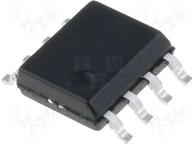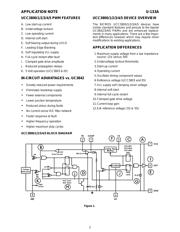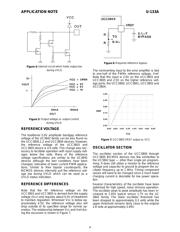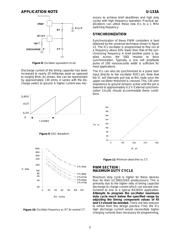herunterladen

Unitrode
Part #
Max Duty
Cycle
VRef
(V)
UVLO
Turn-On
UVLO
Turn-Off
UCC3800 100% 5.0 7.2 6.9
UCC3801 50% 5.0 9.4 7.4
UCC3802 100% 5.0 12.5 8.4
UCC3803 100% 4.0 4.1 3.6
UCC3804 50% 5.0 12.5 8.4
UCC3805 50% 4.0 4.1 3.6
Power supply design has become increasingly more challenging as engineers confront the difficulties of
obtaining higher power density, improved performance and lower cost. The control for many of these
switchmode supplies was revolutionized with two significant introductions; an advance technique known as
current mode control, and a novel PWM solution, the UC3842 controller. This IC contained several innova-
tive features for general purpose current mode controlled applications. Included were high speed circuitry,
undervoltage lockout, an op-amp type error amplifier, fast overcurrrent protection, a precision reference
and a high current totem-pole output.
The popular UC3842 control circuit architecture has been recently improved upon to deliver even higher
levels of protection and performance. Advanced circuitry such as leading edge blanking of the current
sense signal, soft-start and full cycle restart have been built-in to minimize external parts count. Addition-
ally, these integrated circuits have been developed on a BiCMOS wafer fabrication process geared to virtu-
ally eliminate supply power and propagation delays in comparison to the bipolar UC3842 devices. These
sophisticated new BiCMOS controllers, the UCC3800 through UCC3805 pulse width modulators address
the challenges presented by the upcoming generations of power supply designs. This application note will
highlight the features incoporated into this new generation of PWM controllers in addition to realizeable en-
hancements in typical applications. The specific differences between members of the UCC3800/1/2/3/4/5
family are reflective of their maximum duty cycle, undervoltage lockout thresholds and reference voltage
which are summarized in the following table.
UCC 3800/1/2/3/4/5 BiCMOS
CURRENT MODE CONTROL ICs
BILL ANDREYCAK
INTRODUCTION
APPLICATION NOTE U-133A
Verzeichnis








